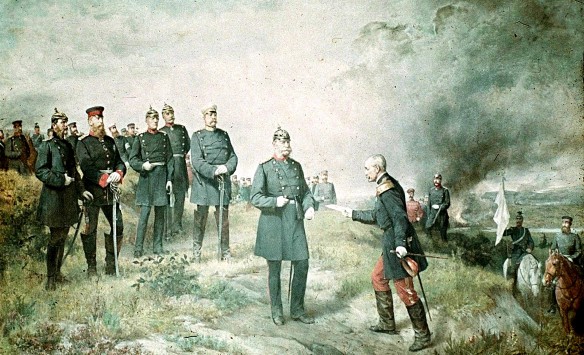
A mural painted in 1884 by Carl Steffeck depicts General Reille delivering Napoleon’s letter of surrender to King William I at the Battle of Sedan in September 1870. It was at the former Ruhmeshalle in Berlin and was destroyed by bombs during World War II.
The most decisive German victory of the Franco-Prussian War. With the French Army of the Rhine under Marshal Bazaine besieged in Metz, the last hope for France rested with the Army of Châlons, commanded by Marshal Patrice MacMahon. MacMahon’s options were to either race east to Bazaine’s aid or to retire to the west and use the strong fortifications around Paris to support his defense. The stronger course of action would be to retreat west, but MacMahon was under great pressure from the Empress Eugénie and her advisors. Furthermore, the Emperor Napoleon III himself was with MacMahon’s army, and retreat would have dealt a grave blow to the political stability of the Empire. The Army of Châlons marched east.
To counter this threat, the German commander, General Helmuth von Moltke, split his forces into four armies. Leaving two to keep Bazaine contained at Metz, he ordered the other two to head west and find MacMahon. German cavalry probing ahead found indications that the Army of Châlons was heading northeast, perhaps to reach Metz via Sedan and Thionville, hugging the Belgian border. It would have been a grave risk for the Germans if they had turned north to pursue, only to find the French were not there. If the French move was a feint, Moltke would be presenting his left flank to MacMahon. On the other hand, if MacMahon was retiring to safety around Paris, the Germans would lose as much as a week reforming and chasing after the French, giving them ample time to bolster the defenses of Paris. Moltke was prepared to gamble and accordingly ordered the two armies to turn north and cut off MacMahon’s line of advance. Through forced marches, the Germans caught up with the French and stopped the Army of Châlons at the town of Sedan, a few miles from the Belgian border, on August 31.
The Army of Châlons was now caught in a triangle-shaped position, surrounded by German forces on all sides. On September 1, the Germans commenced their final assault. Early in the action MacMahon was severely wounded, but there was confusion as to who would take his place. MacMahon appointed General Auguste Ducrot as acting commander; however, a more senior general and recent arrival, Emmanuel Wimpffen, refused to take orders from Ducrot and insisted he was now in charge. The two commanders disagreed over which direction the army should attempt a breakout. Ducrot advocated a breakout to the west and a return to Paris; Wimpffen ordered an attack to the east and a continuation of the drive to relieve Metz. Either option was doomed to failure. The German artillery controlled the heights above Sedan on all sides and was able to rain down artillery fi re from different directions on the French troops below. There was no cover, and thousands of French soldiers and horses were cut to pieces. A few units were able to sneak to the north and into neutral Belgium, where they were interned, but the rest either died or were captured. By the end of the day, the French had suffered 3,000 men killed, 14,000 wounded, and 21,000 more taken prisoner, including the Napoleon III and MacMahon; over the next few days, the total French prisoner count reached nearly 100,000. The Germans’ total losses—killed, wounded, and missing—were only 9,000, the vast majority of which had been incurred by a few ill-advised infantry assaults by commanders too impatient to let the artillery do their work for them. The defeat at Sedan was the last gasp of the French Second Empire and opened the road to Paris for the victorious German armies.
FURTHER READING: Howard, Michael. The Franco-Prussian War. New York: Collier, 1969; Wawro, Geoffrey. The Franco-Prussian War: The German Conquest of France, 1870–1871. New York: Cambridge University Press, 2003; Wetzel, David. A Duel of Giants: Bismarck, Napoleon II and the Origins of the Franco-Prussian War. Madison: University of Wisconsin Press, 2001.